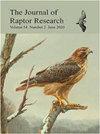FACTORS INFLUENCING PREVALENCE AND INTENSITY OF HAEMOSPORIDIAN INFECTION IN AMERICAN KESTRELS IN THE NONBREEDING SEASON ON THE BAJA CALIFORNIA PENINSULA, MEXICO
IF 1.2
4区 生物学
Q2 ORNITHOLOGY
引用次数: 0
Abstract
Overwintering areas can act as reservoirs for haemosporidians, and their blood-sucking vectors may easily survive and flourish in warm climates. The American Kestrel (Falco sparverius) is a small-sized raptor that includes both resident and migratory individuals that overwinter in agriculture areas of the Baja California peninsula, Mexico. We measured and collected blood samples from 54 individual kestrels captured in a fragmented habitat located within a matrix of agricultural and native scrub in the southern part of the peninsula during the autumn and winter of 2018–2019 and 2019–2020. We identified and quantified haemosporidians in blood smears of each individual. We used decision tree classification models of prevalence and intensities of haemosporidians to assess the importance of season, host body size, and environmental characteristics of the capture site (proximity to the nearest infected host, number of ponds used for irrigation, Normalized Difference Vegetation Index [NDVI], distance to the edge of the agricultural matrix, and distance to the nearest city). Overall prevalence was 42.6%, with an average intensity of 2.4 haemosporidian-infected cells per 2000 erythrocytes. Most haemosporidians (91.3%) were identified as Haemoproteus tinnunculi, and the rest as Plasmodium spp. The prevalence of haemosporidians increased with pond availability, the distance from the edge of the agricultural matrix, and the proximity of infected individuals. Parasite intensity increased with the availability of ponds, the distance to the edge of the agriculture matrix, and the NDVI. Spatial and temporal patterns of parasite prevalence and intensity illustrated local infection dynamics, suggesting a complex scenario of haemosporidian transmission in migratory and resident kestrels.墨西哥下加利福尼亚半岛非繁殖期美洲红隼血孢子虫感染流行及强度的影响因素
越冬地区可以成为血孢子虫的宿主,它们的吸血媒介很容易在温暖的气候中存活和繁殖。美洲红隼(Falco sparverius)是一种小型猛禽,包括在墨西哥下加利福尼亚半岛的农业地区过冬的常驻和迁徙个体。我们在2018-2019年和2019-2020年秋冬期间,在半岛南部农业和原生灌木基质内的破碎栖息地捕获了54只红隼,并测量并收集了它们的血液样本。我们在每个个体的血涂片中鉴定和定量血红孢子虫。我们使用决策树分类模型来评估血孢子虫的流行和强度,以评估季节、宿主体型和捕获地点的环境特征(与最近的感染宿主的距离、用于灌溉的池塘数量、归一化植被指数[NDVI]、到农业基质边缘的距离以及到最近的城市的距离)的重要性。总体患病率为42.6%,平均强度为每2000个红细胞2.4个血孢子虫感染细胞。大多数血孢子虫(91.3%)被鉴定为锡氏血孢子虫,其余为疟原虫。血孢子虫的流行率随池塘的可用性、离农业基质边缘的距离和感染个体的距离而增加。寄生蜂强度随池塘的可用性、到农业基质边缘的距离和NDVI的增加而增加。弓形虫的流行和强度的时空格局说明了当地感染的动态,表明在迁徙和常驻红隼中存在复杂的弓形虫传播情况。
本文章由计算机程序翻译,如有差异,请以英文原文为准。
求助全文
约1分钟内获得全文
求助全文
来源期刊

Journal of Raptor Research
生物-鸟类学
CiteScore
2.30
自引率
17.60%
发文量
61
审稿时长
>12 weeks
期刊介绍:
The Journal of Raptor Research (JRR) is an international scientific journal dedicated entirely to the dissemination of information about birds of prey. Established in 1967, JRR has published peer-reviewed research on raptor ecology, behavior, life history, conservation, and techniques. JRR is available quarterly to members in electronic and paper format.
 求助内容:
求助内容: 应助结果提醒方式:
应助结果提醒方式:


